#galapagos green
Text
Pantone del giorno 13/12 - Galapagos Green
Natale o no, in questi freddi giorni di inverno capita di non poter fare a meno di pensare alle spiagge coralline di isole lontane e al tepore del sole estivo. Ebbene, Il Galapagos Green di Pantone è una tonalità di verde che ricorda la rigogliosa vegetazione delle Isole Galapagos. È un colore che può essere utilizzato in una diversa varietà di capi d’abbigliamento, da abiti e gonne a giacche e…

View On WordPress
#13 dicembre#abiti#adobe#azzurro#bianco#camicetta#canva#colori vivaci#fashion#fashion design#fashion moodboard#galapagos green#giacca di jeans#giallo#giornate di primavera#gonne#inverno#jeans azzurri#moda#moodboard#natale#nero#pantaloni#pantaloni palazzo#pantaloni skinny#pantone#progetti#rosa#tabatha moda design#tonalità di verde
0 notes
Text
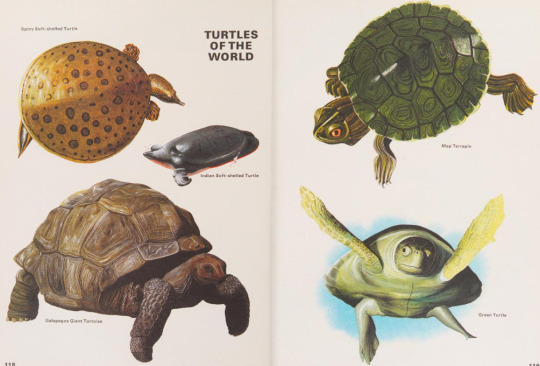
The Quizzer Book of Knowledge: Nature. Written and edited by George Beal. 1978.
Internet Archive
#reptiles#turtles#softshell turtles#spiny softshell turtle#indian shoftshell turtle#map terrapins#sea turtles#green sea turtles#tortoises#galapagos tortoise
168 notes
·
View notes
Text
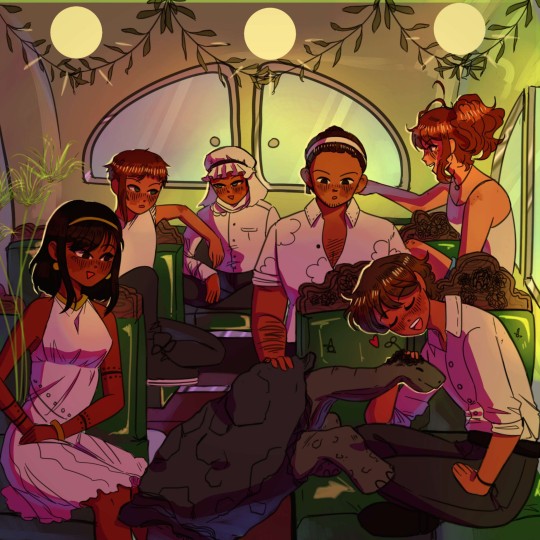
Apparently I never posted this jeje
#Oh hello#Sorry this blog is practically dead#Anyway#My art#surprisingly#hws ancient Egypt#aph ancient egypt#hws equador#nyo Italy#hws nyo Italy#hws cuba#aph cuba#hws egypt#aph egypt#hws cyprus#aph cyprus#and the Galapagos giant turtle jejeje#Finished this months ago#very very green thing going on here#some things are weird and I would change them now but I was on a rush back then#akfbjsnxs now I just have to sit here and look at my mistakes#hopefully learn from them#Hetalia#hetalia world stars
60 notes
·
View notes
Text

Green sea turtles will often take two breaths at the surface; a shorter initial one, followed by a longer and deeper one. The space between them is just enough time for a photographer to try to look at their picture of the first breath and then completely miss the longer, more photogenic second breath.
(Green sea turtle)
#photography#art#outdoors#nature#digital art#animals#wildlife#adventure#outdoor#green sea turtle#sea turtle#galapagos islands#galapagosexpeditionann#galapagos#travel#travelphotography
30 notes
·
View notes
Text
youtube
From the biggest plastic treaty in history to lizards making love for the first time in 200 years, here are some of the biggest climate wins of 2022.
#climate #animals #Earth #Environment #ClimateCrisis #NowThis
#now this earth#now this#solarpunk#plastic treaty#lizards#galapagos#jaguar#yucatán peninsula#Mexico#conservation#wolves#bears#bison#biodiversity#plastic pollution treaty#plastic pollution#pollution#renewable energy#green energy#fossil fuels#Youtube
24 notes
·
View notes
Text

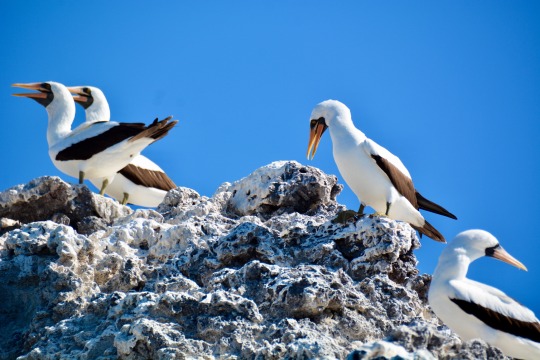
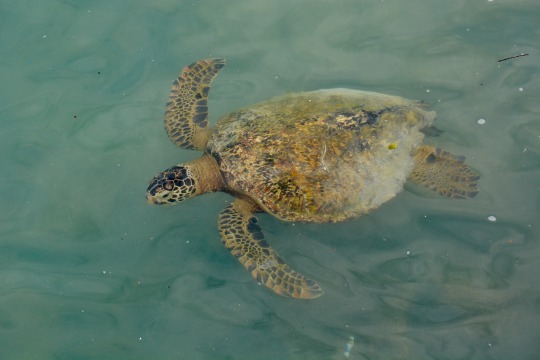


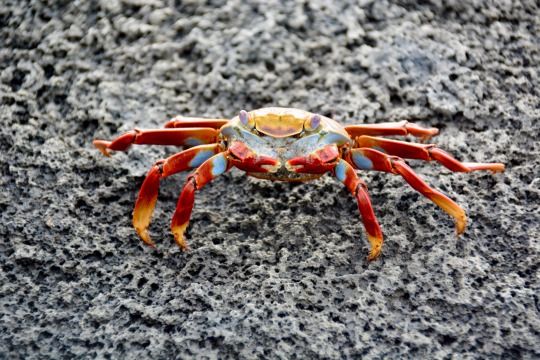


Just a few shots from my return to the Galápagos… a place that only gets more incredible the more time you spend there.
#galapagos#giant tortoise#nazca booby#green sea turtle#cownose ray#Galapagos land iguana#sally lightfoot crab#galapagos penguin#sea lion#my photos
6 notes
·
View notes
Photo

A green sea turtle navigates the azure waters surrounding the Galápagos Islands.
PHOTOGRAPH BY MICHAEL S. NOLAN, NAT GEO IMAGE COLLECTION
#michael s nolan#photographer#national geographic#green sea turtle#turtle#galapagos islands#nature#marine photography
25 notes
·
View notes
Text
The largest beak in the genus Geospiza is shown in Fig. 1, and the smallest in Fig. 3; but instead of there being only one intermediate species, with a beak the size shown in Fig. 2, there are no less than six species with insensibly graduated beaks. The beak with the sub-group Certhidea, is shown in Fig. 4.

"Journal of Researches into the Natural History and Geology of the Countries Visited During the Voyage of H.M.S. Beagle Round the World, 1832-36" - Charles Darwin
#book quotes#the voyage of the beagle#charles darwin#nonfiction#galapagos islands#finch#darwin's finches#evolution#beak#geospiza magnirostris#large ground finch#geospiza fortis#medium ground finch#geospiza parvula#camarhynchus parvulus#small tree finch#certhidea olivacea#green warbler finch#geospiza#certhidea#birds
1 note
·
View note
Text
Baby Galapagos Pink Land Iguanas Observed for the First Time
For the first time ever baby Galapagos pink land iguanas have been observed! The critically endangered species has an estimated adult population of 200-300 animals, which researchers worried were beginning to decline due to age. A ten month search found nesting sites and hatchlings on Isabela Island, in a remote area near Wolf Volcano. Like the name suggests adult Galapagos pink land iguanas are a shade of bright pink, however, babies are bright green with black spots.
[Photo credit: Galapagos National Park]

3K notes
·
View notes
Text
I haven't talked reptiles in Wet Beast Wednesday in a while (and the first time I did it got like 9 notes) so I'll do it again with marine iguanas. Admittedly they're more amphibious than aquatic, but there's no Moist Beast Monday and I think they're cool so it'll have to do.
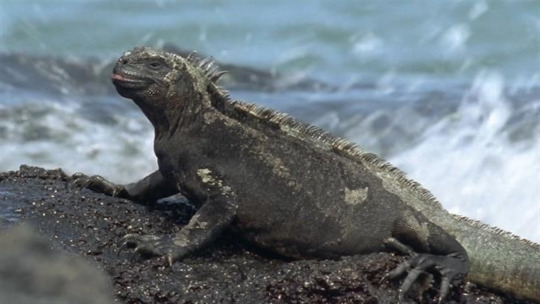
(Image: Doug Jones in The Shape of Water a marine iguana basking on a rock)
Marine iguanas (Amblyrhynchus cristatus) are large lizards native to the Galapagos Islands. They are unique for being the only extant lizards that spend time in the ocean. As of 2017, there are 11 distinct subspecies that are isolated from each other by the islands they live on. Occasionally a member of one subspecies will end up on the wrong island and produce hybrid offspring. Marine iguanas also can but very rarely do hybridize with the land iguanas of the Galapagos, with whom they are believed to share a common ancestor.
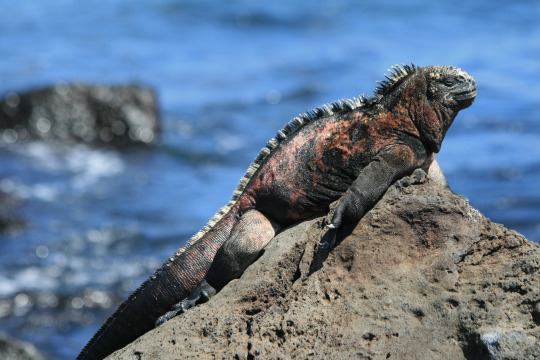
(Image: an iguana perched on a rock
Marine iguanas vary in size based on subspecies, with those from smaller islands reaching a smaller adult size. In general, they race from 12 to 56 cm (4.7 - 22 in) from snout to rear, with a tail ranging from 17 to 84 cm (6.7 - 33.1 in). Males are significantly larger than females, up to twice the weight and noticeably longer. Marine iguanas are robust, with relatively short limbs. Their leg bones are heavy, to provide ballast while swimming. Their tails are laterally flattened and provide propulsion for swimming. They have a row of spines down their backs that provide stability while swimming, similar to a fish's dorsal fin. Their feet have powerful claws and can be used to cling onto and push off of undersea rocks. Marine iguanas were noted by many explorers for their dark color, including Charles Darwin (who referred to them as "clumsy" and "disgusting"). This dark color helps them warm up quickly after diving in the sea.

(image: an iguana going for a swim)
A major feature of the marine iguana is its diet, which is a huge factor in their semiaquatic lifestyle. They feed almost exclusively on green and red algae that grown underwater. To reach the algae, females and smaller males browse the intertidal zone during low tide, while larger males and abnormally large females can swim out to the deeper subtidal zone to forage. They can spend an hour underwater one one breath and dive to 30 m (98 ft), but most dives are much shallower and shorter. Only the largest males swim offshore and dive to significant depths for their food. Because they are positively buoyant, divers must actively swim or cling onto rocks to stay underwater. Most individuals will return to the same spot for feeding and competition over feeding spots have been known to happen. Larger males that swim out for their food have the advantage of less competition for their feeding spots. The species has adapted to be able to fast or subsist on reduced for long periods. During El Nińo, where food supplies can be reduced for years, they will actually shrink, with even their bones getting shorter, then return to full size once the food supply is restored. Because they consume excess salt with their food, marine iguanas have developed the ability to filter the salt out of their blood and expel it through glands in their nostrils. The secreted salt can then be sneezed away. Juveliles spend the first few months of their life feeding on (WARNING: GROSS) the feces of older iguanas. This helps them develop the culture of symbiotic gut bacteria that helps them digest algae. In fact, their digestive systems are so specialized to algae that they can't switch diets.

(image: a marine iguana grazing on algae underwater)
As ectotherms (cold-blooded animals), marine iguanas need to keep themselves warm to survive. The water around the Galapagos is typically around 11-23 degrees C (52-75 F) while their preferred body temp is 35-39 C (95-102 F). This high preferred temperature helps with their digestion. To keep themselves warm, the iguanas spend a lot of their time basking in the sun, especially after swimming. They can also reduce their heart beats while cold to help prevent heat loss. Basking iguanas can cover large beaches. They live in colonies that usually range between 20 and 500 individuals but can sometimes get up to 1000 members. Their biomass to area ratio can be the highest of any reptile. While they are considered gregarious, they display no social behavior such a grooming. The closest they get to a group activity is sleeping next to each other to conserve heat at night. They also get along with other species, such as Darwin's finches, mockingbirds, and crabs who will pick parasites off their skin. Divers may allow cleaner fish to pick off bits of dead skin. Another lizard, the lava lizard, likes to visit colonies to hunt flies attracted to the iguanas. The iguanas allow the much smaller lizards to climb all over them. Marine iguanas often share beaches with Galapagos sea lions, who will occasionally allow the iguanas to climb over them.
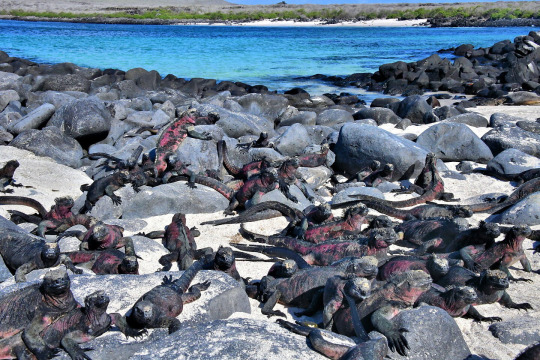
(image: a group of iguanas basking together)
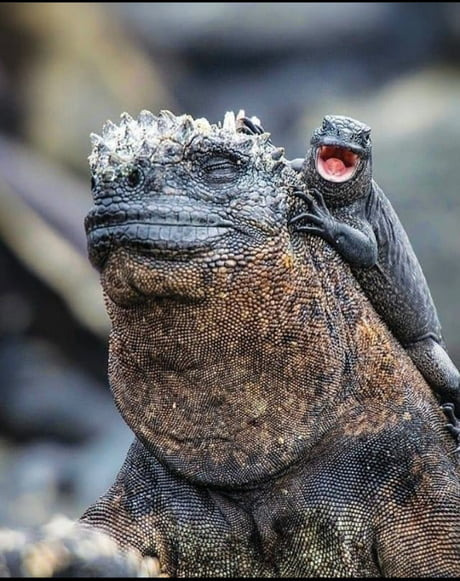
(image: a male marine iguana, identifiable by the rough scales on his head, with a lava lizard climbing on him)
During mating season, male iguanas stop being as chill with their neighbors, attempting to establish a territory and push other males out. They also change from their normal dark appearance to a much brighter coloration. Territories are usually bordered by rocks or crevasses and can be found next to each other in groups. Males will attempt to attract females to their territories while fighting other males to get access to their females. This behavior is called lekking. Females show a distinct preference for larger males and it is the largest males that are most successful at maintaining territories. Medium males are forced to patrol the edges of territories to try to pick up mates while small males often pretend to be female to sneak into another's territory and attempt to mate. Males with territories defend them with special displays where they will raise their dorsal spines and open their mouths while bobbing their heads around. If another male challenges the dominant, they will display at each other. If neither submits, a fight will start. Males fight by headbutting and trying to push each other around. These fights can last for hours and the participants will occasionally take breaks. In most cases, one will eventually display a submissive posture and retreat, though in a few cases the fight has escalated to biting and scratching. When courting a female, a male will nod at her and approach in a sideways walk. Smaller males without territories may also try mating forcibly. Females only mate once per year and will signal rejection to additional suitors by nodding at them.
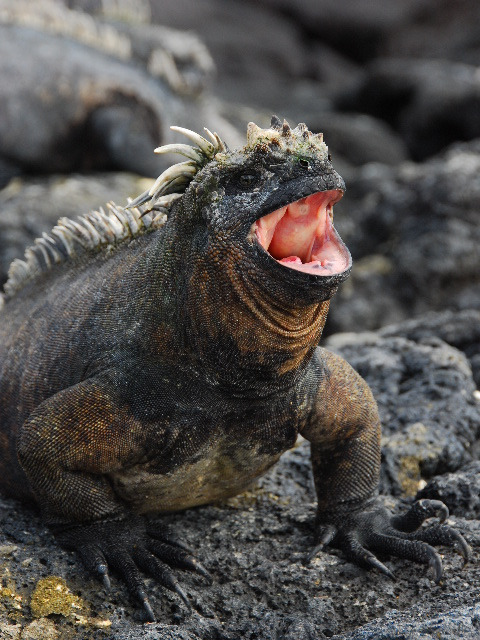
(image: a male performing a territorial display)

(image: two males headbutting each other in a territorial battle)
Mating season usually lasts between December and March. Females will lay eggs about a month after mating. The eggs (usually 2 to 3 but sometimes up to 6) can collectively weigh up to a quarter of the mother's weight, which is very large for an iguana. They are laid well above the tide line and buried in sand or soil. In places with few good nesting sites, mothers will guard their eggs after hatching to make sure other females don't dig therm up to steal the spot. When females fight over nesting spots they are less disciplined than males and will quickly resort to biting. The eggs hatch after 3-4 months. Females reach sexual maturity after 3-5 years while males do so after 6-8 years. They live an average lifespan of 12 years, but can live up to 60.

(image: a female iguana digging her nest)
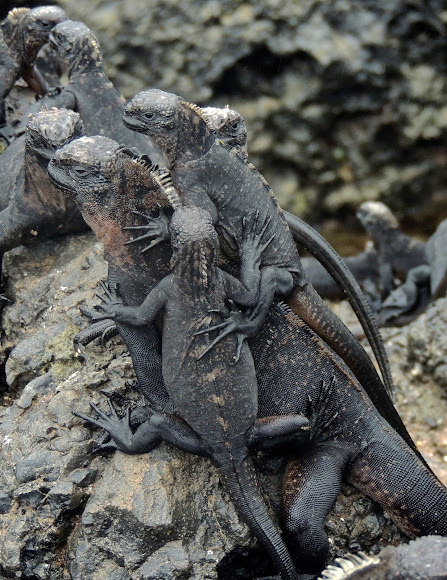
(image: a group of juveniles climbing on each other)
Marine iguanas are classified as vulnerable by the IUCN, while a few populations are instead considered endangered. A major threat to them is warming seas, which can reduce the red and green algae populations and replace them with inedible brown algae, leading to starvation. Marine iguanas only have a few predators and most of them target juveniles or small adults. As a result, the adults demonstrate island tameness, a lack of wariness to potential predators. This has left them vulnerable to predators introduced by humans, such as dogs, cats, rats, and pigs. Despite these invasive predators being present for ver 100 years, they have not developed any anti-predator defenses against them, a phenomenon called ecological naïveté. They also do not fear humans and will allow tourists to approach them, which has led to injuries and the spread of human-introduced diseases. They are protected by laws of Ecuador and most of their range is in protected areas. Efforts to remove invasive predators have seen some benefit. They are difficult to keep in captivity due to their specialized diets, and they have never been bred in captivity.

(image: a male with his bright mating season coloration)
#wet beast wednesday#marine iguana#biology#zoology#ecology#marine biology#galapagos#animal facts#iguana#lizard#reptile#long post
178 notes
·
View notes
Note
Top 5 reptiles in gross excruciating detail
Boy oh boy it's show time!

Ball Python
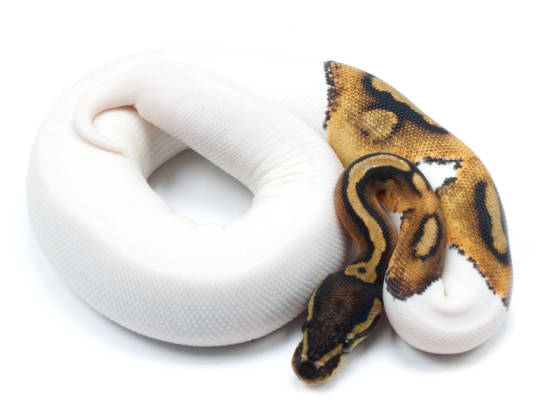
Yes I know that's basic bitch taste, but LOOKATIM. CUTIEPATOOTIE
A generally well-size snake, and I adore all the colors they can have! So pretty to look at. I specially love em big snoots. Literally owo-ing 24-7, what else can I ask for?
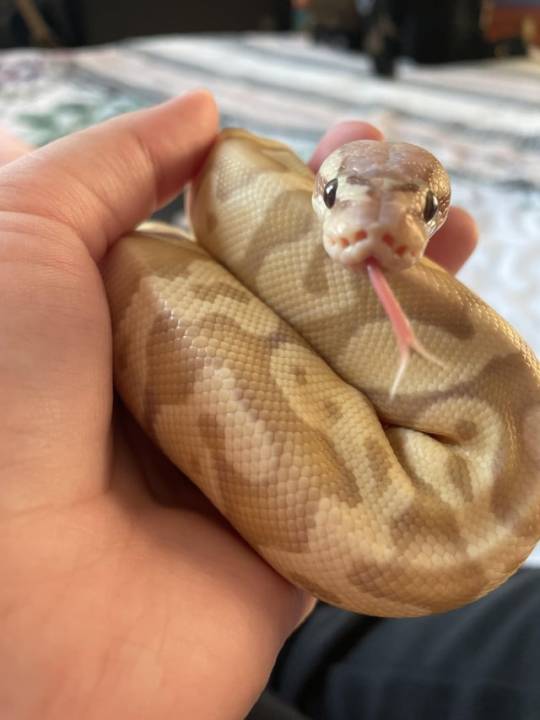


Galapagos

Just a big ass guy. Look at him. HUGEEEE individual.
Honestly I don't really know, I just think it's cool that there are turtles the size of dogs. My man is titanic. Honestly, if I had the space I would LOVE to house one of these guys (don't let em near dogs, I just thought that pic was a good size approximation)
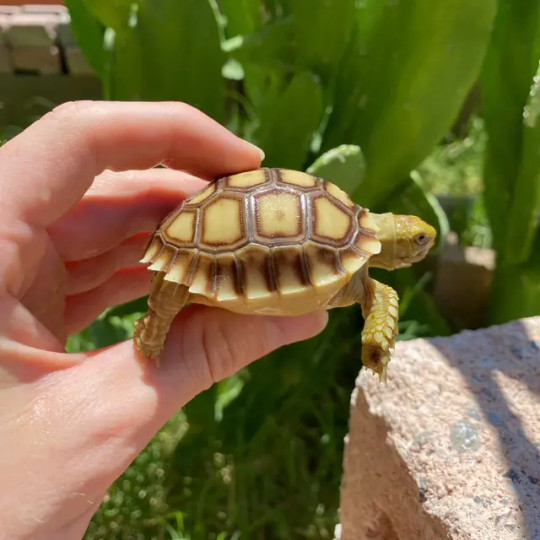
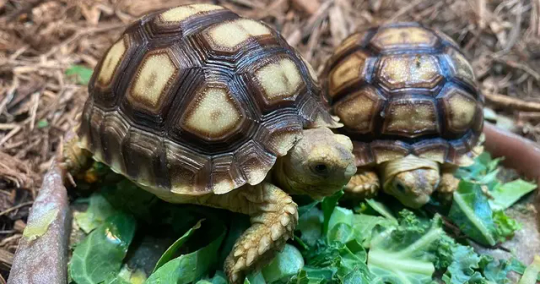
Satanic leaf tail
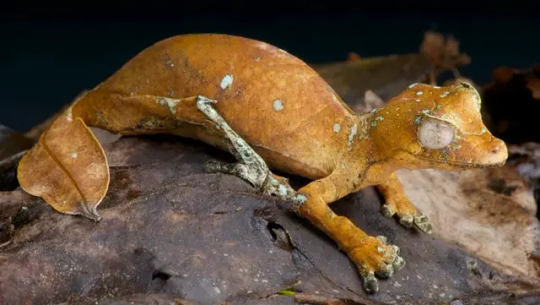
LOOK AT HIM, this guy is metal AF and I love everything of it. The heads shape is SOOOOOO fun and I love animals that camouflage. Their tiny Lil feetsies are so CUTE, and I adore their eyes with them tiny pupils. I'm never forgiving treecko for making this concept into "just some guy" who then turns into a generic-ass Dino, so much potential wasted. I gotta give em justice some day and make an honest to god dark-grass type fakemon. Or maybe even just dark-something and the grass is a lurantis scenario.
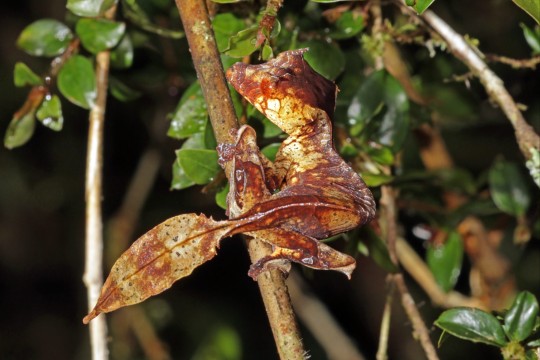
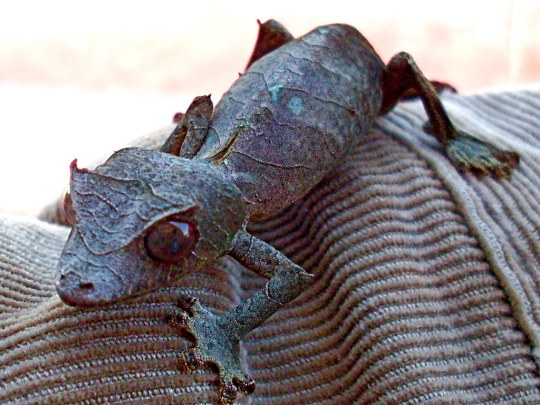
Chrysopelea
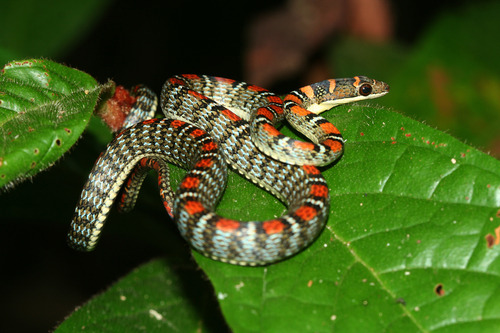
Ok but picture this:
A snake
That fucking GLIDES


Bitch goes in top of trees and then just fucking JUMPS and GLIDES for half a kilometer and then lands unharmed and repeats again. Because that's her locomotion method. Girl just JUMPS from high places and does aerodynamic shit and boom, ur 200 meters from where you started. Metal af


RES

Ok I KNOW this one is polemic, specially knowing they are driving to extinction an endemic species over here, BUT JUST LOOK AT EM
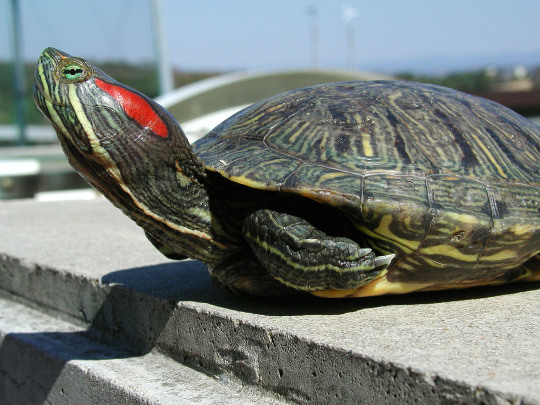
I just adore these guys, all from their silly lil-permanently angry faces to their marking and asking patterns, to the vibrancy of their "ears" marks, just such guys. I also adore how when babies they are such a soft emerald hue but they start getting more and more dark as they age and once they are adults they are all these mixes of rich forest green with light olive green strikes in their shells, they are sosososoooo pretty


Cameo of my Lil guy Olivo being eepy because I adore him to bits

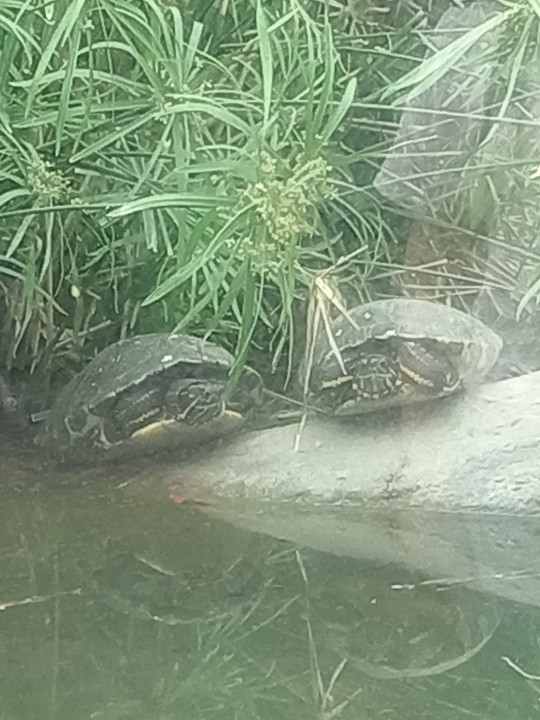
Also a pic of the afro mentioned almost extinct endemic species, because I felt like it. We have some at the zoo and we just went a course on how to teach the public on why it's important to care for em and all that jazz. Pretty cool ngl
sorry for taking so long to asnwer! i just got hit by "honestly i dont really wanna do anything rn ngl" diseas and had to rest for 2 days. Have a painting of my doggo as compensation

#Asks#Ask#Reptile#Reptiles#herpetology#red eared slider#ball python#sulcata tortoise#Satanic leaf gecko#Gecko#turtle#tortoise#Snake#Text#Textpost#Infodump
23 notes
·
View notes
Note
In Master and Commander, far side of the world, there's a bit where there's a giant dessert(???) brought out in the shape of the Galapagos Islands. And I gather it's some sort of jelly, but what is it likely flavoured with? Is it sweet or savory? The little ship looks like it's made of cheese, but the sea is green. What produce could they have on a ship, that far from home, in that time period, to make something like that?
Hi,
I have already thought about this and researched what it could be. The consistency is that of a pudding and a jelly. And judging by the time, 1805- it should probably be a chocolate pudding (has been around since 1740) and a lemon jelly. It depends on what's on board, of course, but that's the closest. As to what the Acheron was made of, well, it could have been cheese or ship's biscuits. But I'm not sure, these are just guesses.
49 notes
·
View notes
Text
zoo pics!!!
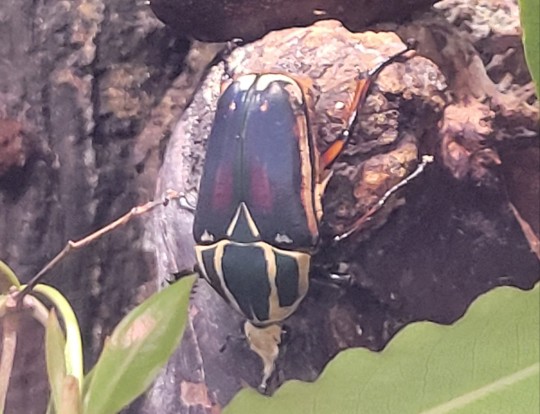
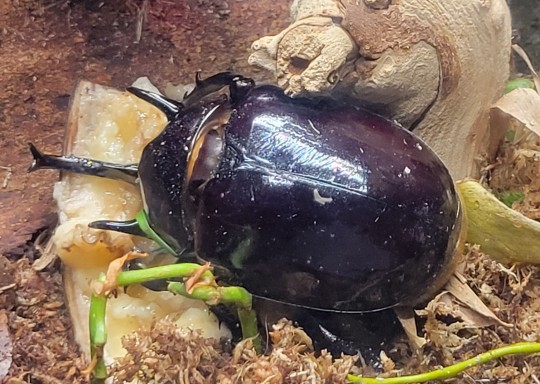
giant flower beetle & rhinoceros beetle
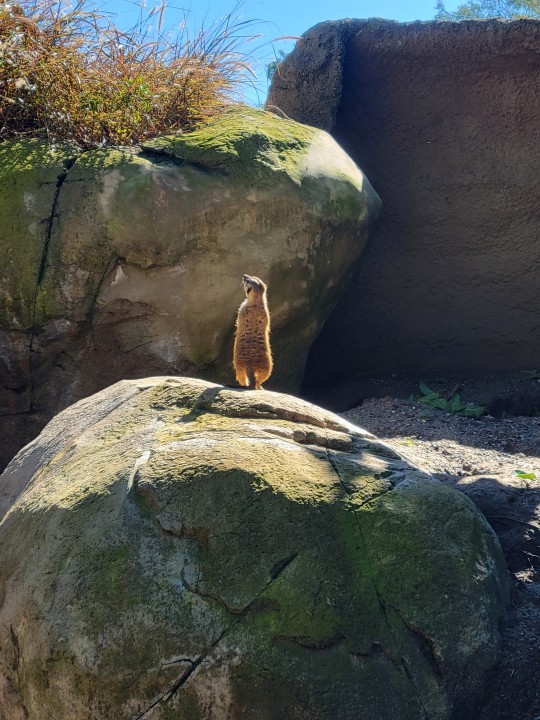

meerkat & jaguar (her name is nindiri and she is STUNNING close up but she wasn't pacing near the front today)
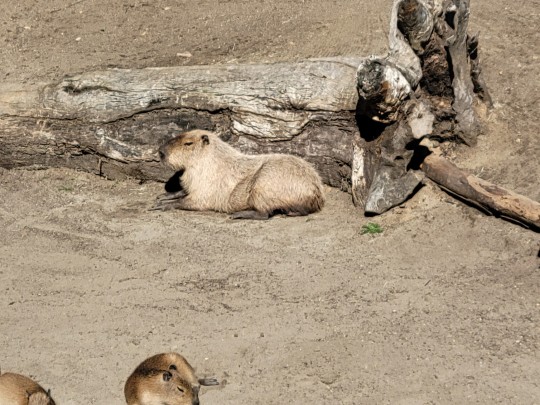

capybaras & galapagos tortoises
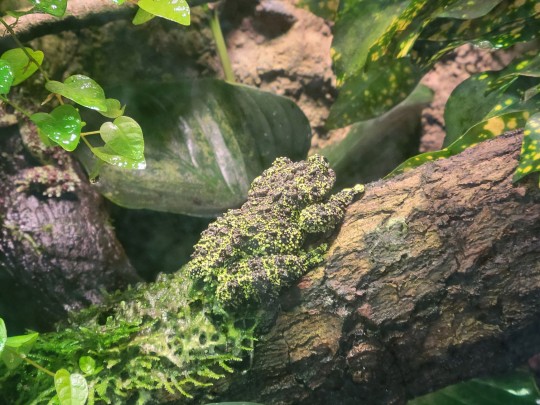
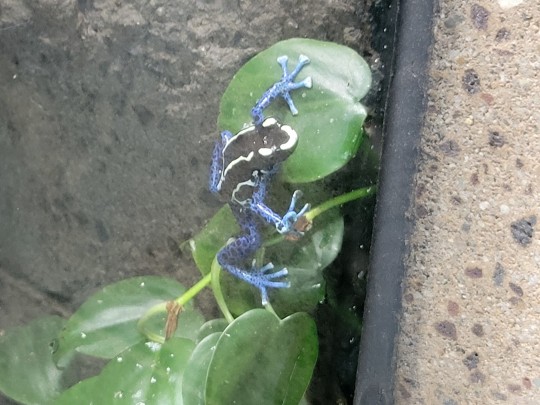
mossy frog & dyeing poison frog
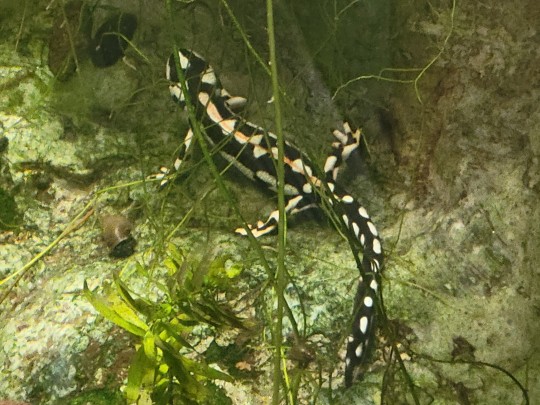
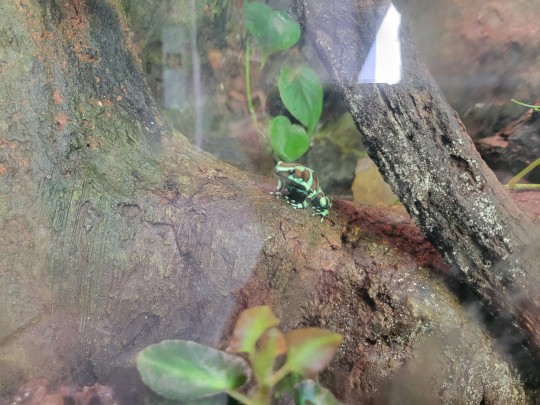
kaiser newt & green and black poison frog
#bell.txt#bugs#frogs#will throw snakes and more stuff in the rbs#posting from my phone bc google photos is not cooperating
24 notes
·
View notes
Text



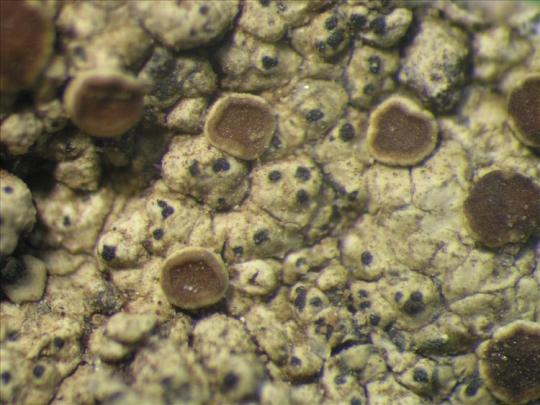


Sucioplaca diplacia (syn. Caloplaca diplacia)
When people think of tropical species, they usually think of extremes and color and poison and variety! But that's not always the case. While there is much lichen diversity in the tropics, it typically takes the form of really similar-looking, typical crustose lichens like S. diplacia. That doesn't mean they are boring! Just more like, easily overlooked. This crustose lichen has a rimose (cracked and clay-like) to areolate (tile-like) thallus of dark or pale blue-gray surrounded in a thin, black prothallus. It produces pale-green soredia from pustule-like and often merged soralia. It has kinda weird apothecia which start out pale and lecanorine, and then becoming larger, confluent, and gall-like as they get bigger, turning dark red-brown. S. diplacia grows on costal rock and maybe bark in sheltered, dusty areas of Central America, the Caribbean, and Galapagos Islands.
images: source | source
info: source
#lichen#lichens#lichenology#lichenologist#mycology#fungi#ecology#biology#nature#bryology#phycology#fungus#symbiosis#symbiotic organisms#algae#Sucioplaca diplacia#Sucioplaca#trypo#trypophobia#natural science#environmental science#life science#weird nature#beautiful nature#I'm lichen it#lichen a day#daily lichen psot#lichen subscribe
32 notes
·
View notes
Text
Setting Map: The World (2125-2800)
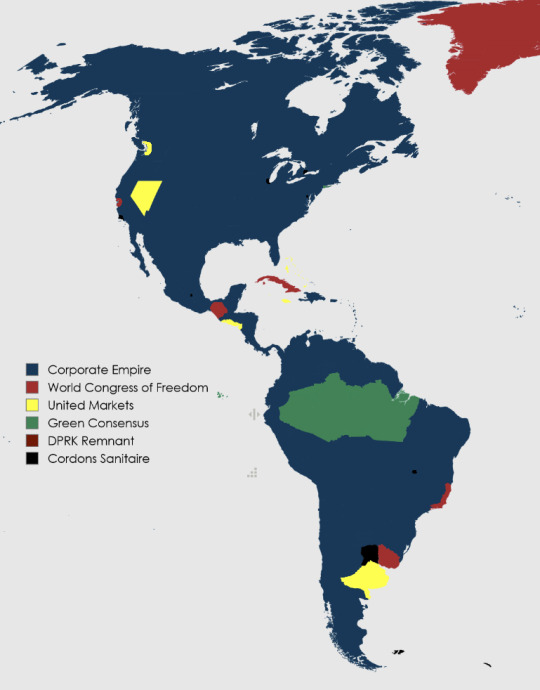
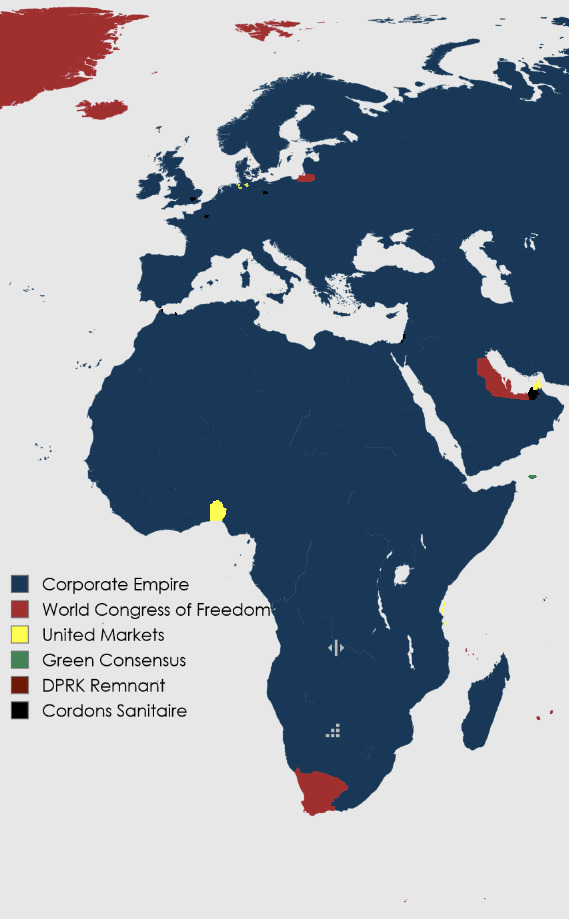
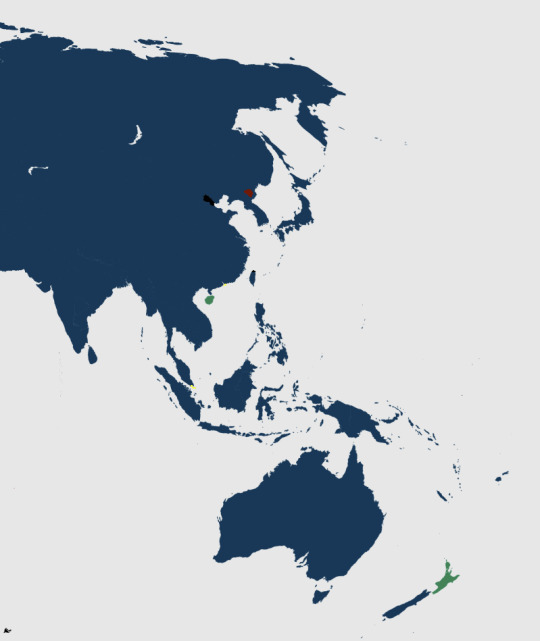
The Corporate Empire (CorpEmp): The big kahuna, and hegemonic empire to end all hegemonic empires. Their territory is more porous than they like to let on, as there are plenty of survivalist, pacifist, and millenarian enclaves (or folks that forgot to fill out their census paperwork) known collectively as the Reserves.
World Congress of Freedom (WCOF): Several urban centers and islands were designated as Cordons Sanitaire, semi-independent penal colonies where aaaalllllll the people that didn't want to be CorpEmp could go live. After Emperor Ignacio died in 2100, multiple Cordons revolted. The left-wing coalition of rebels formed the WCOF. Although they didn't overthrow CorpEmp, they won the next best thing: CorpEmp's begrudging recognition.
United Markets (UM): The right-wing half of the Cordon rebellion, though they preferred to bribe their way to freedom from CorpEmp than fight. The peace treaty that ended the Cordon Rebellion was signed in Las Vegas (all parties involved got comped rooms!) They are an equal mix of Anarcho-Capitalists and billionaire/tech-bro megacorps.
Green Consensus: The Long Island Cordon was full of hippies and less smelly environmentalists, so CorpEmp didn't invest too many resources in monitoring them. Then Ignacio dies, and all hell breaks loose across the Cordons. While the new Empress unleashed Operation JANISSARY on the rebels, the newly christened "Green Consensus" plants their environmentally friendly flag on the Amazon, Galapagos, and various islands (how Heinan and North Island ended up joining is a mystery). CorpEmp didn't contest, after fighting a 25 year war with two other factions.
DPRK Remnant: No one knows why the remains of the Democratic People's Republic of Korea got the San Marino treatment during the creation of CorpEmp. All modern historians know is that the Mount Paektu bloodline were left alone to rule their namesake. Not much info comes out.
Cordons Sanitaire: These are the ones that didn't make it. CorpEmp was able to take these Cordons during the Rebellion and kept them as Cordons in the Treaty of Las Vegas. It's Escape from New York 24/7/365 here.
Common Prosperity Coalition (CPC): They're not on the map, because no one wants them on it. They're the descendants of the many, many criminal organizations that survived WW3, the Warlords' Wars, and the creation of CorpEmp. They like to think they're on par with the Big Three (much to the Big Three's chagrin).
#my setting#setting#worldbuilding#setting lore#setting map#feedback appreciated#need to add more wcof/um/cordons in the 3rd map but not sure where
7 notes
·
View notes
Text
Tagged by @lazaefair (ty!) for the:
Get to know you better
Relationship Status: Perpetually (by choice) single
Favorite Colors: Blue & Green
Three Favorite Foods: Pretzels (of the soft and baked variety), good Italian pizza, and perogies
Song Stuck in My Head: Blame My Ex, by the Beaches (bc I figured out a plot for a fic for this song)
Last Song I Listened To: Something off Hozier's Unreal Unearth album
Last Thing I Googled: Something work-related to my new job re: discount program
Time: Mid afternoon
Dream Trip: There's a few rattling around my brain at all times and I am hindered by cost:
2 weeks in the Galapagos Islands
Antarctica in depth
2 months in New Zealand & Australia (a return to NZ, plus new stuff)
Anything I Really Want Right Now: I want tomorrow to be here so I can go to new job and start addressing fear of unknowns bit by bit
Tagging @sulkybender, @insidious-intent, @queermil @rainehunting @project-pleiades
28 notes
·
View notes